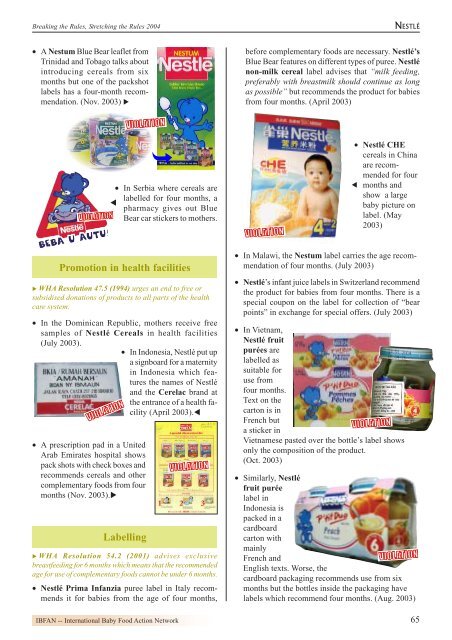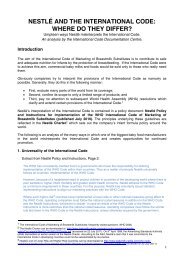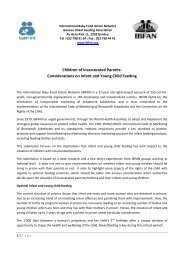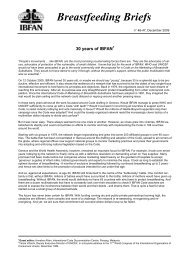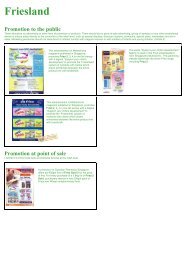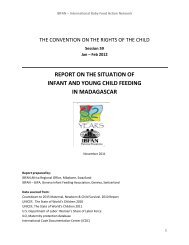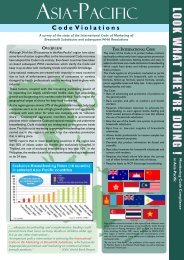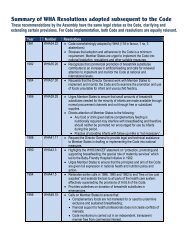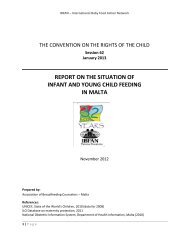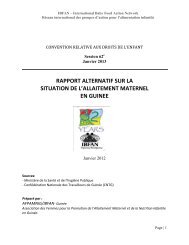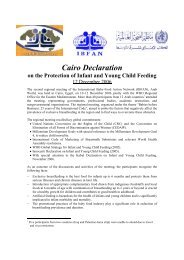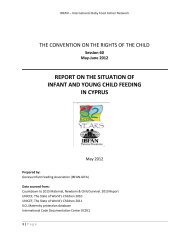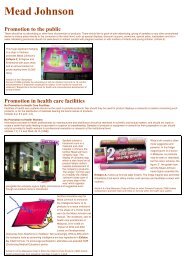You also want an ePaper? Increase the reach of your titles
YUMPU automatically turns print PDFs into web optimized ePapers that Google loves.
Breaking the Rules, Stretching the Rules 2004 NESTLÉ<br />
• A Nestum Blue Bear leaflet from<br />
Trinidad and Tobago talks about<br />
introducing cereals from six<br />
months but one of the packshot<br />
labels has a four-month recommendation.<br />
(Nov. 2003) �<br />
• In Serbia where cereals are<br />
labelled for four months, a<br />
�<br />
pharmacy gives out Blue<br />
Bear car stickers to mothers.<br />
Promotion in health facilities<br />
� WHA Resolution 47.5 (1994) urges an end to free or<br />
subsidised donations of products to all parts of the health<br />
care system.<br />
• In the Dominican Republic, mothers receive free<br />
samples of Nestlé Cereals in health facilities<br />
(July 2003).<br />
• In Indonesia, Nestlé put up<br />
a signboard for a maternity<br />
in Indonesia which features<br />
the names of Nestlé<br />
and the Cerelac brand at<br />
the entrance of a health facility<br />
(April 2003).�<br />
• A prescription pad in a United<br />
Arab Emirates hospital shows<br />
pack shots with check boxes and<br />
recommends cereals and other<br />
complementary foods from four<br />
months (Nov. 2003).�<br />
Labelling<br />
� WHA Resolution 54.2 (2001) advises exclusive<br />
breastfeeding for 6 months which means that the recommended<br />
age for use of complementary foods cannot be under 6 months.<br />
• Nestlé Prima Infanzia puree label in Italy recommends<br />
it for babies from the age of four months,<br />
<strong>IBFAN</strong> -- International Baby Food Action Network<br />
before complementary foods are necessary. Nestlé’s<br />
Blue Bear features on different types of puree. Nestlé<br />
non-milk cereal label advises that “milk feeding,<br />
preferably with breastmilk should continue as long<br />
as possible” but recommends the product for babies<br />
from four months. (April 2003)<br />
• Nestlé CHE<br />
cereals in China<br />
are recommended<br />
for four<br />
� months and<br />
show a large<br />
baby picture on<br />
label. (May<br />
2003)<br />
• In Malawi, the Nestum label carries the age recommendation<br />
of four months. (July 2003)<br />
• Nestlé’s infant juice labels in Switzerland recommend<br />
the product for babies from four months. There is a<br />
special coupon on the label for collection of “bear<br />
points” in exchange for special offers. (July 2003)<br />
• In Vietnam,<br />
Nestlé fruit<br />
purées are<br />
labelled as<br />
suitable for<br />
use from<br />
four months.<br />
Text on the<br />
carton is in<br />
French but<br />
a sticker in<br />
Vietnamese pasted over the bottle’s label shows<br />
only the composition of the product.<br />
(Oct. 2003)<br />
• Similarly, Nestlé<br />
fruit purée<br />
label in<br />
Indonesia is<br />
packed in a<br />
cardboard<br />
carton with<br />
mainly<br />
French and<br />
English texts. Worse, the<br />
cardboard packaging recommends use from six<br />
months but the bottles inside the packaging have<br />
labels which recommend four months. (Aug. 2003)<br />
65


